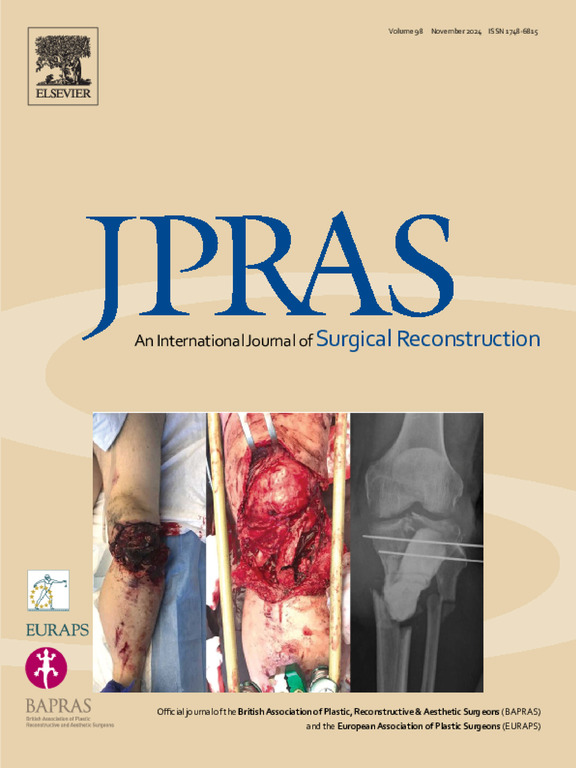从概念到临床实践——揭示再生周围神经界面(RPNI)手术的应用。
IF 2.4
3区 医学
Q2 SURGERY
Journal of Plastic Reconstructive and Aesthetic Surgery
Pub Date : 2025-09-15
DOI:10.1016/j.bjps.2025.08.040
引用次数: 0
摘要
目的:截肢后疼痛影响到美国230万截肢患者中的95%。再生周围神经界面(RPNI)手术是治疗截肢后疼痛和增强假肢控制的一种很有前途的新方法。本研究的目的是随着时间的推移确定这种手术干预的采用,为未来的研究方向和临床应用提供见解。方法:本研究采用趋势分析评估RPNI手术的采用情况。从2011年到2024年,对PubMed和Embase数据库进行了全面的检索,出版物分为基础科学、临床科学和评论文章。提取并分析数据的时间和主题模式。为了补充学术成果,使用术语“RPNI”和“再生周围神经接口”对谷歌搜索趋势进行了初步分析,以评估全球搜索量和平均年增长率。采用SPSS进行统计分析。结果:共检索到文献233篇,其中符合纳入标准的文献106篇,其中基础科学文献26篇(24.5%),临床科学文献40篇(37.7%),综述40篇(37.7%)。发表量显示出显著的上升轨迹(p < 0.001)。总体而言,82%的出版物来自最近5年。主题分析揭示了从早期动物模型和概念验证研究(2011-2015)到转化和早期临床报告(2016-2018)的进展,随后是随机试验、病例系列和靶向肌肉神经移植的比较研究(2019-2021)。最近几年(2022-2024)的特点是系统综述、多机构试验和手术技术的改进(例如血管化和肌肉袖带RPNI)。谷歌搜索数据证实了这些发现,从2011年到2024年,“RPNI”的搜索量增长了16307%,显示出学术和公众的势头。结论:在过去的14年里,RPNI手术获得了显著的进展。应进一步调查长期临床结果和患者报告的经验,以支持已经很有希望的基础科学和临床结果。本文章由计算机程序翻译,如有差异,请以英文原文为准。
From concept to clinical practice-Unraveling the adoption of regenerative peripheral nerve interface (RPNI) surgery
Purpose
Postamputation pain affects up to 95% of the 2.3 million individuals with amputations in the US. Regenerative Peripheral Nerve Interface (RPNI) surgery is a promising new approach for managing postamputation pain and enhancing prosthetic control. The purpose of this study was to determine the adoption of this surgical intervention over time to provide insight for future research direction and clinical applications.
Methods
This study was designed as a trend analysis to evaluate the adoption of RPNI surgery. A comprehensive search of the PubMed and Embase databases was conducted from 2011 to 2024, with publications categorized into basic science, clinical science, and review articles. Data were extracted and analyzed for temporal and thematic patterns. To complement academic output, a pilot analysis of Google Search trends was performed using the terms “RPNI” and “Regenerative Peripheral Nerve Interface,” to assess global search volume and average annual growth rates. Statististical analysis was performed using SPSS.
Results
The search identified 233 publications, among which 106 met the inclusion criteria: 26 (24.5%) basic science articles, 40 (37.7%) clinical science articles, and 40 (37.7%) reviews. Publication output demonstrated a significant upward trajectory (p < 0.001). Overall, 82% of the publications were from the last 5 years. Thematic analysis revealed a progression from early animal model and proof-of-concept studies (2011–2015) to translational and early clinical reports (2016–2018), followed by randomized trials, case series, and comparative studies with targeted muscle reinnervation (2019–2021). The most recent years (2022–2024) were characterized by systematic reviews, multi-institutional trials, and refinements in surgical technique (e.g., vascularized and muscle cuff RPNI). Google Search data corroborated these findings, with the search volume for “RPNI” increasing by 16,307% from 2011 to 2024, demonstrating academic and public momentum.
Conclusions
RPNI surgery has gained significant traction over the past 14 years. Long-term clinical outcomes and patient-reported experiences should be further investigated to support the already promising basic science and clinical outcomes.
求助全文
通过发布文献求助,成功后即可免费获取论文全文。
去求助
来源期刊
CiteScore
3.10
自引率
11.10%
发文量
578
审稿时长
3.5 months
期刊介绍:
JPRAS An International Journal of Surgical Reconstruction is one of the world''s leading international journals, covering all the reconstructive and aesthetic aspects of plastic surgery.
The journal presents the latest surgical procedures with audit and outcome studies of new and established techniques in plastic surgery including: cleft lip and palate and other heads and neck surgery, hand surgery, lower limb trauma, burns, skin cancer, breast surgery and aesthetic surgery.

 求助内容:
求助内容: 应助结果提醒方式:
应助结果提醒方式:


